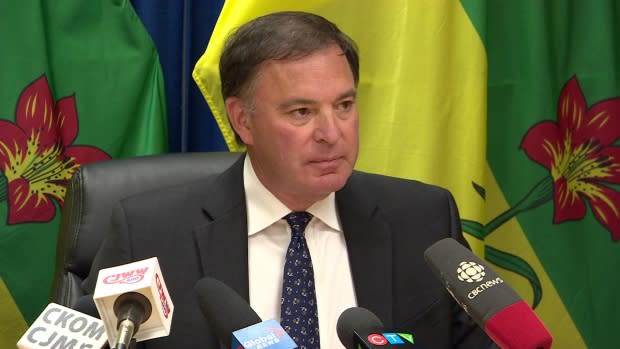Increased size of daughter's class during pandemic worries Saskatoon parent
A Saskatoon parent says her back-to-school anxiety worsened after she found out her daughter would be in a bigger class than the one she was in last year, despite returning to school during the COVID-19 pandemic.
Tamara Hinz saw the size of her daughter's class increase by three students. The Grade 2 student now has 25 classmates, compared to 22 last year.
"My heart kind of sank when I learned that," said Hinz, who says she and her family have been working hard to follow the province's COVID-19 guidelines.
"It just felt really counterintuitive and a bit anxiety-provoking, I guess, to go against all of those instincts that we've been practising the last several months," she said.
Hinz says she's aware that concerns around class sizes in Saskatchewan were raised prior to the pandemic, and notes her school has been doing amazing work.
But she feels the provincial government should be putting a greater emphasis on class size as more is learned about how COVID-19 is spread.
"It just really, I think, should be accelerating the conversation about reduced class sizes and making that more of a priority," she said.

CBC Saskatoon requested an interview with Education Minister Gordon Wyant to discuss Hinz's concerns, but a statement was provided instead.
School division enrolments and staffing figures have not yet been submitted to the ministry, the statement said.
"Enrolment counts will be submitted on Sept. 30, as they are each year, but we will be monitoring enrolment changes monthly," the ministry's statement said, noting it's working with school divisions to get "a sense of what education choices parents across the province are making."
The ministry said school divisions are in the best position to determine staffing levels that reflect the need of their students, noting they have taken a variety of measures to minimize the risk of COVID-19 transmission in schools.
Meetings of the Committee on Class Size and Composition have also resumed and the ministry says it continues its work on the creation of a framework that will help guide school divisions on appropriate class size and composition within the province's classroom.
The statement did not address questions about why the Ministry of Education did not include class-size requirements in its initial guidance to school divisions.
Hundreds of new staff to be hired: minister
Earlier this week, Minister Wyant said that $51 million in funding has been approved to continue making schools safe during the pandemic, with 46 applications coming from the province's public schools.
"This significant investment will ensure that our school divisions have the resources they need to respond and plan for emergent items," said Wyant.

The Saskatchewan Teachers' Federation, which represents 13,500 teachers in the province, has been critical of the provincial government's back-to-school plan since it was released in early August.
The government has since amended the plan, pushing back the start of school and allocating $40 million from a government COVID-19 contingency fund worth roughly $200 million to support divisions as they return to school.
However, federation president Patrick Maze says he feels the government missed the mark by not including class-size requirements in any of the guidance it provided to the province's 27 school divisions.
He said while the public and members of the business community are enforcing things like physical distancing and smaller indoor crowds, when it comes to schools, it appears government has decided "all bets are off."
'Double standard' for school system: STF
"That's been a big frustration for teachers right from the start,… Where is the social distancing?" said Maze.
"The big problem is it comes down to money. And clearly, government hasn't been willing to spend money on significantly reducing class size in order to keep students and teachers safe."
Maze said he feels the government has created a "double standard" for the education system.
"Some businesses are on actually the threshold of going under, or have gone under, in order to keep social distancing to the recommended level," he said. "Yet here in schools, you can have a classroom of 36 students."
Indian Head Elementary School, in the Prairie Valley School Division, has already resorted to online learning for the start of the school year after a staff member tested positive for COVID-19.

The government of Saskatchewan has provided numerous pieces of information to school divisions in regards to what should be included in their return-to-school plan, but the divisions and schools will be responsible for implementing the plans on the front lines.
Maze said what will happen in the coming weeks is "anybody's guess" but noted the STF is concerned about a looming shortage of substitute teachers, and potentially teachers in general, if staff and students need to start isolating in large numbers.
Anxiety, but 'a lot of joy': teachers association head
John McGettigan, president of the Saskatoon Teachers' Association — which represents more than 4,000 educators in the city and surrounding areas — said the start of the school year has lifted some spirits.
"In the last few days, there's been a lot of joy," he said.
"These teachers missed their kids a lot. Obviously there's still an underlying anxiety that everybody in society is feeling, but I have to say, when the kids started walking through the doors, teachers got their purpose back."
In recent days, health officials with the provincial government have recommended against interprovincial travel, with Premier Scott Moe saying one of the best ways to keep COVID-19 out of schools is to keep it out of the community as a whole.
While the government of Saskatchewan is confident in its back-to-school plan, with Minister Wyant saying he has no regrets, the province's chief medical health officer has advised parents to expect disruptions throughout the year as potential cases are discovered and isolated.


